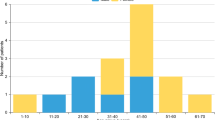Abstract
We report a novel case of a radiation-induced cavernous malformation developing in a vestibular schwannoma previously treated with stereotactic radiosurgery. Eleven years after treatment, the patient presented with a large predominantly cystic lesion in the cerebellopontine angle. We performed surgery, and a solid vascular lesion was identified within the schwannoma, which was determined to be a cavernous malformation after histopathological analysis. We review the literature of radiation-induced cavernous lesions, illustrating that while rare, these lesions do pose concern as a long-term complication of brain radiation therapy. We also discuss the possibility that radiation-induced cavernous malformation-like lesions are pathologically distinct from cavernous malformations.









Similar content being viewed by others
Abbreviations
- SRS:
-
Stereotactic radiosurgery
- RICM:
-
Radiation-induced cavernous malformation
- CM:
-
Cavernous malformations
- CPA:
-
Cerebellopontine angle
- Gy:
-
Gray
- MRI:
-
Magnetic resonance imaging
- WBRT:
-
Whole brain radiotherapy
References
Cha YJ, Nahm JH, Ko JE, Shin HJ, Chang JH, Cho NH, Kim SH (2015) Pathological evaluation of radiation-induced vascular lesions of the brain: distinct from de novo cavernous hemangioma. Yonsei Med J 56:1714–1720
Cutsforth-Gregory JK, Lanzino G, Link MJ, Brown RD Jr, Flemming KD (2015) Characterization of radiation-induced cavernous malformations and comparison with a nonradiation cavernous malformation cohort. J Neurosurg 122:1214–1222
Di Giannatale A, Morana G, Rossi A, Cama A, Bertoluzzo L, Barra S, Nozza P, Milanaccio C, Consales A, Garre ML (2014) Natural history of cavernous malformations in children with brain tumors treated with radiotherapy and chemotherapy. J Neuro-Oncol 117:311–320
Ellis TL, Neal MT, Chan MD (2012) The role of surgery, radiosurgery and whole brain radiation therapy in the management of patients with metastatic brain tumors. International Journal of Surgical Oncology 2012:952345
Engh JA, Kostov D, St Martin MB, Yeaney G, Rothfus W, Hirsch B, Kassam AB (2010) Cavernous malformation tumors: a case study and review of the literature. Otol Neurotol 31:294–298
Keezer MR, Del Maestro R (2009) Radiation-induced cavernous hemangiomas: case report and literature review. J Can Sci Neurol 36:303–310
Kleinschmidt-DeMasters BK, Lillehei KO (2016) Radiation-induced cerebral vascular “malformations” at biopsy. J Neuropathol Exp Neurol
Lew SM, Morgan JN, Psaty E, Lefton DR, Allen JC, Abbott R (2006) Cumulative incidence of radiation-induced cavernomas in long-term survivors of medulloblastoma. J Neurosurg Pediatr 104:103–107
Maiodna E, Ahmad FU, Morcos JJ (2016) Cavernous malformation of the seventh cranial nerve: case report and review of literature. World neurosurgery 91:676.e613–676.e621
Martins AN, Johnston JS, Henry JM, Stoffel TJ, Di Chiro G (1977) Delayed radiation necrosis of the brain. J Neurosurg 47:336–345
Mitchell G (2013) The rationale for fractionation in radiotherapy. Clin J Oncol Nurs 17:412–417
Nimjee SM, Powers CJ, Bulsara KR (2006) Review of the literature on de novo formation of cavernous malformations of the central nervous system after radiation therapy. Neurosurg Focus 21:e4
Oldenburg MS, Carlson ML, Van Abel KM, Giannini C, Jacob J, Rivas A, Driscoll CL, Link MJ (2015) Cavernous hemangiomas of the internal auditory canal and cerebellopontine angle. Otol Neurotol 36:e30–e34
Park HJ, Griffin RJ, Hui S, Levitt SH, Song CW (2012) Radiation-induced vascular damage in tumors: implications of vascular damage in ablative hypofractionated radiotherapy (SBRT and SRS). Radiat Res 177:311–327
Rueß D, Pöhlmann L, Grau S, Hamisch C, Hellerbach A, Treuer H, Kocher M, Ruge MI (2017) Long-term follow-up after stereotactic radiosurgery of intracanalicular acoustic neurinoma. Radiat Oncol 12:68
Ruggeri AG, Donnarumma P, Pichierri A, Delfini R (2014) Two cystic cavernous angiomas after radiotherapy for atypical meningioma in adult woman : case report and literature review. J Korean Neurosurg Soc 55:40–42
Siemann DW (2011) The unique characteristics of tumor vasculature and preclinical evidence for its selective disruption by tumor-vascular disrupting agents. Cancer Treat Rev 37:63–74
Takado Y, Minakawa T, Hadeishi H, Yoshida Y (2009) A mass in the cerebellopontine angle presenting with subarachnoid haemorrhage. J Clin Neurosci 16(1051):1117
Uneda A, Yabuno S, Kanda T, Suzuki K, Hirashita K, Yunoki M, Yoshino K (2017) Cavernous angioma presenting with subarachnoid hemorrhage which was diffusely distributed in the basal cisterns and mimicked intracranial aneurysm rupture. Surg Neurol Int 8:202
Valk PE, Dillon WP (1991) Radiation injury of the brain. AJNR Am J Neuroradiol 12:45–62
Wolf A, Kvint S, Chachoua A, Pavlick A, Wilson M, Donahue B, Golfinos JG, Silverman J, Kondziolka D (2017) Toward the complete control of brain metastases using surveillance screening and stereotactic radiosurgery. J Neurosurg:1–9
Zhou J, Li N, Yang G, Zhu Y (2011) Vascular patterns of brain tumors. Int J Surg Pathol 19:709–717
Acknowledgements
We would like to acknowledge the editing support of Superior Medical Experts.
Funding
United Hospital Foundation provided financial support in the form of grant funding. The sponsor had no role in the design or conduct of this research.
Author information
Authors and Affiliations
Corresponding authors
Ethics declarations
Disclosures
Kevin Kallmes holds equity in and works for Superior Medical Experts.
Conflict of interest
The authors declare that they have no conflict of interest.
Ethical approval
All procedures performed in studies involving human participants were in accordance with the ethical standards of the institutional and/or national research committee and with the 1964 Helsinki declaration and its later amendments or comparable ethical standards. For this type of study, formal consent is not required.
Informed consent
Informed consent was obtained from all individual participants included in the study.
Additional information
This article is part of the Topical Collection on Brain Tumors
Electronic supplementary material
Table S1
(DOCX 62 kb)
Rights and permissions
About this article
Cite this article
Nussbaum, L.A., Kallmes, K.M., Bellairs, E. et al. De novo cavernous malformation arising in the wall of vestibular schwannoma following stereotactic radiosurgery: case report and review of the literature. Acta Neurochir 161, 49–55 (2019). https://doi.org/10.1007/s00701-018-3734-2
Received:
Accepted:
Published:
Issue Date:
DOI: https://doi.org/10.1007/s00701-018-3734-2




